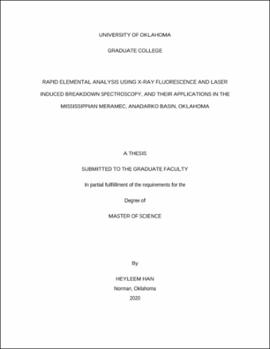| dc.description.abstract | X-Ray fluorescence (XRF) and Laser Induced Breakdown spectroscopy (LIBS) are rapid elemental analysis techniques for rock cores and cuttings. Elemental analysis is useful in understanding geochemical, mineralogical, diagenetic and petrophysical characteristics of rock formations. Specific elemental concentrations, or their ratios, can be used as proxies to understand sedimentary depositional environments, diagenetic overprints, and organics. High spatial resolution XRF and LIBS data acquisition allow the capture of high frequency spatial changes in rock formations, providing a more accurate decision input for the target zones in horizontal drilling. Also, elemental analysis on cuttings across multiple wells can help geoscientists build a more robust reservoir model. The application of these scanning techniques reduces analysis time and quickens decision making.
Elemental analysis on eight cores of the Mississippian Meramec in STACK (Sooner Trend Anadarko basin Canadian and Kingfisher counties) play was conducted using XRF and LIBS instruments. High resolution mineralogy profiles were generated from elemental data using internal inversion software which showed a trend with clay increasing and calcite decreasing in the depositional direction (NW to SE). From this elemental mineralogy database, both geological and petrophysical information were extracted.
A model to predict high resolution porosity profiles was built using XRF elemental and mineralogy data. Brittleness is a formation property used in completion decisions. Mineralogy composites from elemental data were used to calculate a brittleness index. Furthermore, I attempted to identify the zones with biogenic quartz using Si and Zr proxies.
During the Mississippian period, most of the study area was covered by carbonate systems, and carbonate diagenesis was observed throughout the core. By integrating point count petrographic analysis with XRF data, quantification of carbonate diagenesis using Sr-ratio (Sr/(Ca+Mg)) was conducted. In the depositional direction, an increase of Sr-ratio implies that the formation suffered less carbonate diagenesis. High spatial resolution XRF data can capture formation heterogeneity. By comparing the 2 inch spatial resolution profile and 2 foot resolution profiles derived from smoothing XRF data, quantification of the degree of heterogeneity across the wells was performed. In the depositional direction, the formation became less heterogeneous as less discrepancy between the two rescaled data sets is observed. Lastly, in the distal direction, total organic carbon (TOC) concentration from LIBS as well as GRs and clay index were observed to increase. | en_US |
